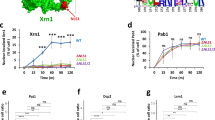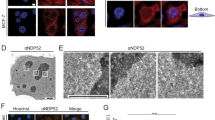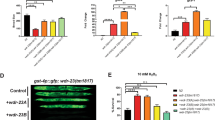Abstract
Dlk (also termed ZIP kinase) is a novel serine/threonine kinase with a unique C-terminal domain that is rich in arginine and contains three putative NLS motifs and a functional lecuine zipper. Dlk is indeed localized in the nucleus where it shows a speckled distribution. To elucidate the biological functions of Dlk, we wanted to identify the signals relevant for nuclear transport and further the nuclear structures which Dlk binds to. Expression of various deletion and point mutations of Dlk as GFP fusion proteins revealed that the leucine zipper is required for association with speckles and the most C-terminal NLS is necessary and sufficient for nuclear transport. Interestingly, a C-terminal deletion mutant defective for nuclear transport exhibited a pronounced colocalization with actin filaments and, even more strikingly, was a very potent inducer of apoptosis. This apoptotic activity was abrogated, however, when this mutant was retargeted to the nucleus via a heterologous NLS from large T, indicating that Dlk only exerts an apoptotic activity in the cytoplasm. To identify the speckle like structures to which Dlk binds we performed immunofluorescence analyses with antibodies directed against representative marker proteins of replication, transcription, or splicing centers. None of these marker proteins revealed a colocalization with Dlk. Instead, we found a partial colocalization with PML bodies which seem to play a key role in regulation of apoptosis. Taken together, these data strongly suggest a functional role for Dlk in control of cell survival which is dependent on its subcellular localization.
This is a preview of subscription content, access via your institution
Access options
Subscribe to this journal
Receive 50 print issues and online access
$259.00 per year
only $5.18 per issue
Buy this article
- Purchase on Springer Link
- Instant access to full article PDF
Prices may be subject to local taxes which are calculated during checkout






Similar content being viewed by others
References
Bloch DB, Chiche J-D, Orth D, DeLaMorte SM, Rosenzweig A and Bloch KD. . 1999 Mol. Cell Biol. 19: 4423–4430.
Cohen O, Feinstein E and Kimchi A. . 1997 EMBO J. 16: 998–1008.
Deiss LP, Feinstein E, Berissi H, Cohen O and Kimchi A. . 1995 Genes Dev. 9: 15–30.
Dragovich T, Rudin CM and Thompson CB. . 1998 Oncogene 17: 3207–3213.
Dyck JA, Maul GG, Miller Jr WH, Chen JD, Kakizuka A and Evans RM. . 1994 Cell 76: 333–343.
Emoto Y, Manome Y, Meinhardt G, Kisaki H, Kharbanda S, Robertson M, Ghayur T, Wong WW, Kamen R and Weichselbaum R. . 1995 EMBO J. 14: 6148–6156.
Fabrizio P, Laggerbauer B, Lauber J, Lane WS and Luhrmann R. . 1997 EMBO J. 16: 4092–4106.
Franke TF, Kaplan DR and Cantley LC. . 1997 Cell 88: 435–437.
Green DR. . 1998 Cell 94: 695–698.
Hozak P, Jackson DA and Cook PR. . 1994 J. Cell Sci. 107: 2191–2202.
Ichijo H, Nishida E, Irie K, ten Dijke P, Saitoh M, Moriguchi T, Takagi M, Matsumoto K, Miyazono K and Gotoh Y. . 1997 Science 275: 90–94.
Jarpe MB, Widmann C, Knall C, Schlesinger TK, Gibson S, Yujiri T, Fanger GR, Gelfand EW and Johnson GL. . 1998 Oncogene 17: 1475–1482.
Johnson NL, Gardner AM, Diener KM, Lange-Carter CA, Gleavy J, Jarpe MB, Minden A, Karin M, Zon LI and Johnson GL. . 1996 J. Biol. Chem. 271: 3229–3237.
Kawai T, Matsumoto M, Takeda K, Sanjo H and Akira S. . 1998 Mol. Cell. Biol. 18: 1642–1651.
Klotzsche O, Etzrodt D, Hohenberg H, Bohn W and Deppert W. . 1998 Oncogene 16: 3423–3434.
Kögel D, Plöttner O, Landsberg G, Christian S and Scheidtmann KH. . 1998 Oncogene 17: 2645–2654.
Lahti JM, Xiang J, Heath LS, Campana D and Kidd VJ. . 1995 Mol. Cell. Biol. 15: 1–11.
LaMorte VJ, Dyck JA, Ochs RL and Evans RM. . 1998 Proc. Natl. Acad. Sci. USA 95: 4991–4996.
Mills JC, Stone NL, Erhardt J and Pittman RN. . 1998 J. Cell. Biol. 140: 627–636.
Murata-Hori M, Suizu F, Iwasaki T, Kikuchi A and Hosoya H. . 1999 FEBS Lett. 451: 81–84.
Page G, Kögel D, Rangnekar V and Scheidtmann KH. . 1999 Oncogene 18: 7265–7273.
Quignon F, De Bels F, Koken M, Ameisen J-C and de The H. . 1998 Nature Genet. 20: 259–265.
Rangnekar V. . 1998 Apoptosis 3: 61–66.
Regnier CH, Song HY, Gao X, Goeddel DV, Cao Z and Rothe M. . 1997 Cell 90: 373–383.
Rittner K, Stöppler H, Pawlita M and Sczakiel G. . 1991 Methods Mol. Cell. Biol. 2: 176–181.
Spector DL, Fu XD and Maniatis T. . 1991 EMBO J. 10: 3467–3481.
Stanger BZ, Leder P, Lee TH, Kim E and Seed B. . 1995 Cell 81: 513–523.
Stuurman N, de Graaf A, Floore A, Josso A, Humbel B, de Jong L and van Driel R. . 1992 J. Cell. Sci. 101: 773–784.
Wang HG, Rapp UR and Reed JC. . 1996 Cell 87: 629–638.
Wang ZG, Ruggero D, Ronchetti S, Zhong S, Gaboli M, Rivi R and Pandolfi PP. . 1998 Nature Genet. 20: 266–272.
Wansink DG, Schul W, van der Kraan I, van Steensel B, van Driel R and de Jong L. . 1993 J. Cell Biol. 122: 283–293.
Widmann C, Gibson S and Johnson GL. . 1998 J. Biol. Chem. 273: 7141–7147.
Wulf E, Deboben A, Bautz FA, Faulstich H and Wieland T. . 1979 Proc. Natl. Acad. Sci. USA 76: 4498–4502.
Xia Z, Dickens M, Raingeaud J, Davis RJ and Greenberg ME. . 1995 Science 270: 1326–1331.
Yao R and Cooper GM. . 1995 Science 267: 2003–2006.
Zandi E, Chen Y and Karin M. . 1997 Science 281: 1360–1363.
Acknowledgements
We thank Dr S Stamm (Max-Planck-Institute of Neurobiology, Munich, Germany) for anti-PML and anti SC35 antibodies and helpful suggestions; Dr R Lührmann (Institute of Molecular Biology and Tumor Research, Marburg, Germany) for antibodies against U5-116 kD (snRNP), G Landsberg for his excellent technical assistance and R Kreutzfeld for help with computer processing of fluorescence pictures. This work was supported by the Deutsche Forschungsgemeinschaft, grant Sche246/4-3 and by means from the Fonds der Chemischen Industrie to KH Scheidtmann.
Author information
Authors and Affiliations
Rights and permissions
About this article
Cite this article
Kögel, D., Bierbaum, H., Preuss, U. et al. C-terminal truncation of Dlk/ZIP kinase leads to abrogation of nuclear transport and high apoptotic activity. Oncogene 18, 7212–7218 (1999). https://doi.org/10.1038/sj.onc.1203169
Received:
Revised:
Accepted:
Published:
Issue Date:
DOI: https://doi.org/10.1038/sj.onc.1203169
Keywords
This article is cited by
-
Cell Death Pathways in Ischemic Stroke and Targeted Pharmacotherapy
Translational Stroke Research (2020)
-
The DAPK family: a structure–function analysis
Apoptosis (2014)
-
ZIP kinase plays a crucial role in androgen receptor-mediated transcription
Oncogene (2008)
-
Identification of proteolytic fragments from ErbB-2 that induce apoptosis
Oncogene (2005)
-
THAP1 is a nuclear proapoptotic factor that links prostate-apoptosis-response-4 (Par-4) to PML nuclear bodies
Oncogene (2003)



